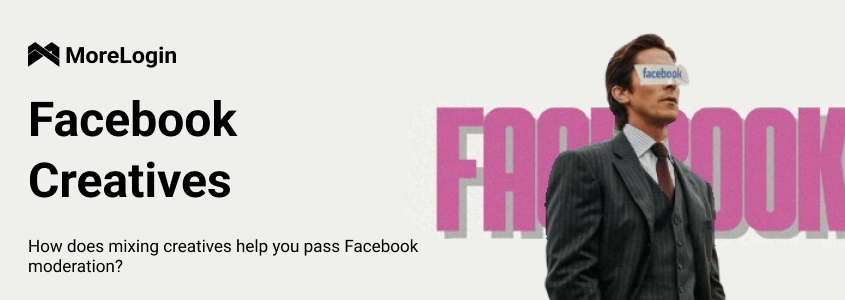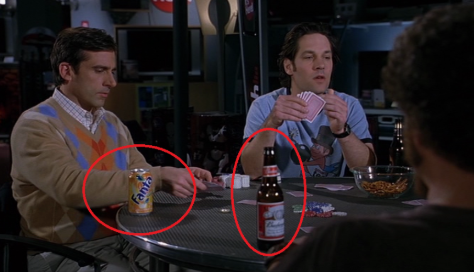
- Product

- Pricing
- Affiliate Program
- Use Cases
- Resource


Combining fake creatives with legitimate promotional materials is arguably one of the most effective strategies for bypassing Facebook moderation in 2025. When done correctly, the platform's algorithms perceive only neutral content and, upon reviewing the full campaign, determine that it complies with Facebook's advertising policies.
In this article, we'll explore several proven creative-mixing techniques and how to apply them effectively to avoid ad rejection.
One of the most powerful ways to hide gray creatives is by designing a collage that mixes both neutral and "working" promotional elements. The key is to assemble a high-quality visual that includes white-listed, safe visuals — such as illustrations on the topic or photos of natural ingredients. Your main gray creative is then subtly embedded into the same composition.

When launching the campaign, simply crop the image so that only the target (gray) part remains visible to users. Moderation systems, however, scan the full collage — which appears neutral and safe. As a result, Facebook's systems often approve the ad without flagging the risky content.
A common tactic with video creatives is to embed your primary promotional clip at the beginning of a long neutral video, often over an hour in duration. The concept is simple: the first few seconds contain your actual promo, followed by harmless, unrelated video content.
This structure allows users to immediately see the offer, while Facebook’s moderation system analyzes the entire video. The large volume of neutral footage reduces the chance of your ad being flagged or rejected, as the risky intro is diluted within a mostly safe context.
Another effective way to pass moderation is by intelligently distributing white and gray creatives across different ad placements on the Facebook Ads platform.
This strategy involves not only designing multiple ad formats but also setting up the technical infrastructure properly — for instance, by using anti-detect browsers like MoreLogin to safely manage your accounts and reduce the risk of bans.

When configuring your campaign, include both standard placements (like Facebook Feed or Instagram Stories) and less common ones, such as:
Search Results
Instagram Explore Home
Messenger Inbox
Facebook Marketplace
Upload neutral creatives (like lifestyle images, educational mini-videos, or product mockups) to these lower-impact placements. Meanwhile, your primary gray creative should go into high-traffic placements.
Why it works:
Facebook reviews your campaign holistically — including all creatives, placements, and their visual tone. By sprinkling in safe elements, the overall campaign appears compliant, significantly lowering the risk of rejection.
.png)
Note: These low-traffic placements won’t generate many clicks, but their real value is in disguising the more aggressive parts of your campaign.
The Carousel format allows you to add multiple images or videos into a single ad unit — making it a perfect tool for creative blending.
Here’s how it works:
First card: Add your primary gray creative. This is what users will see first when scrolling.
Following cards: Fill with white-listed materials — such as product visuals, benefits, testimonials, packaging images, or helpful tips.
Moderation systems review the entire Carousel, not just the first card. If the majority of your content is safe and well-balanced, the algorithm may allow the ad to run — even if the first card is borderline.
Why it works:
Facebook’s moderation AI evaluates the complete context. A well-built Carousel with predominantly safe content can offset the risk of having one gray creative in the mix.
Extra tips:
Avoid stuffing the first card with text or bold visual triggers — it may draw unwanted attention.
Add clear, white-hat descriptions to each card to increase campaign transparency.
Use a mix of card types (image, video, sliders) to make the ad feel more authentic.
CTA buttons should remain compliant and generic — like “Learn More,” “Watch Now,” or “See Details.”
Dynamic creatives are a powerful native feature in Facebook Ads Manager that let you upload multiple headlines, texts, images, and videos. The system auto-combines them into different ad variations and optimizes for performance.
How does this help you bypass moderation?
Simple: upload both white and gray creatives in the same campaign. Facebook's moderation system evaluates the entire creative set, not just one version. Once approved, the algorithm starts testing combinations.
If the gray creative performs well (CTR, engagement, conversions), Facebook may automatically prioritize it — even if it skirts the edge of policy compliance.
Why it works:
Facebook prioritizes performance. If a borderline creative generates significantly better results, it often gets more impressions — as long as the overall campaign appears safe at the start.
Step-by-step setup:
Create a campaign with “Conversions” or “Traffic” as the objective.
Enable “Dynamic Creatives” in the ad set.
Upload 3–5 white-listed visuals (product shots, lifestyle images, etc.).
Add your main gray creative.
Write 3–5 headline and description variations — mixing safe and performance-driven copy.
Launch and monitor performance.
To successfully pass Facebook moderation in 2025, it’s crucial to mix multiple strategies:
Collage-based masking
Long video embedding
Smart placement distribution
Carousel format blending
Dynamic creative optimization
Each method by itself offers protection, but the real power lies in their combination. When used together, these techniques provide a robust framework for campaign longevity — helping you not only pass moderation but also maintain high ad performance under Facebook’s increasingly strict policies.